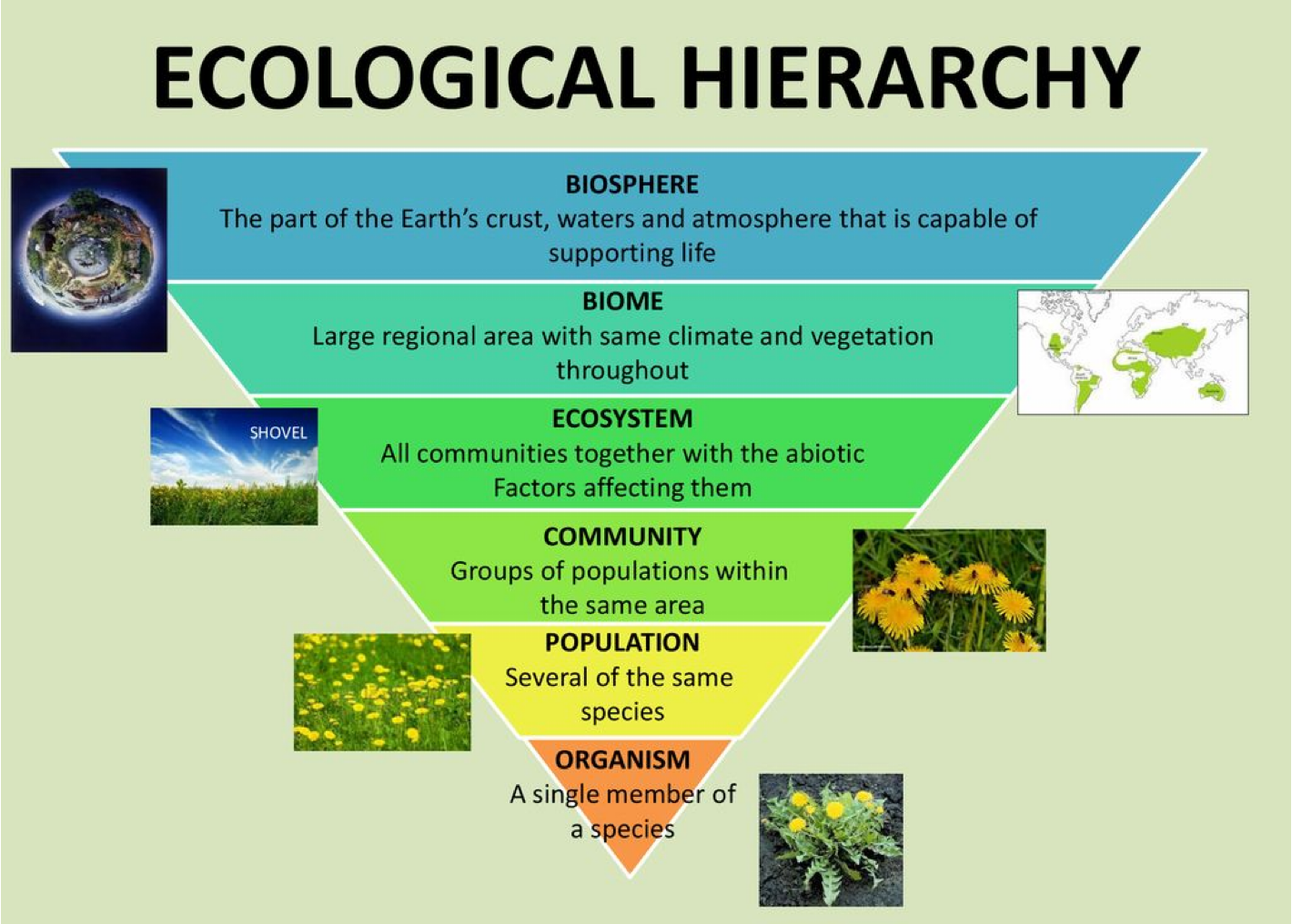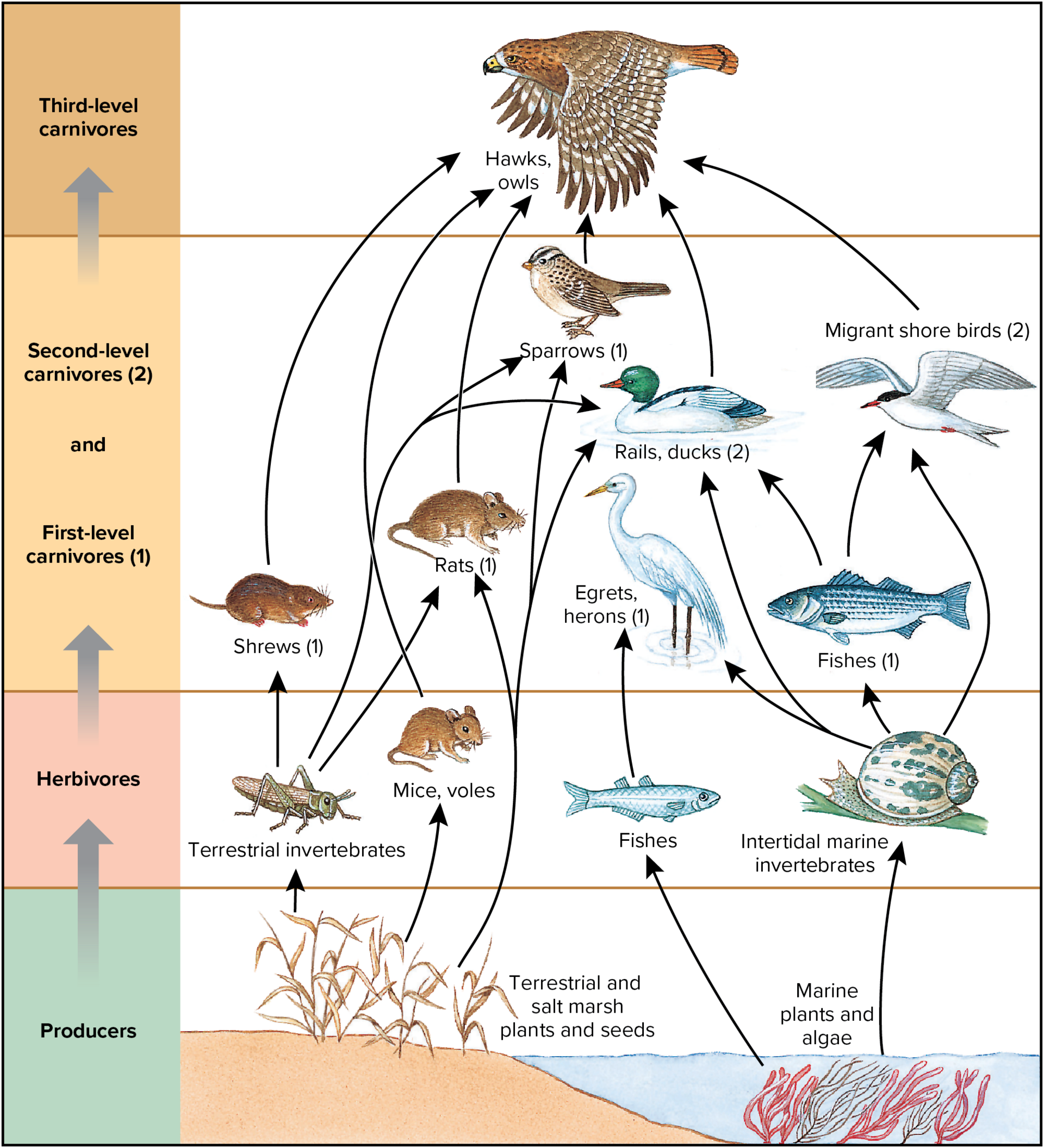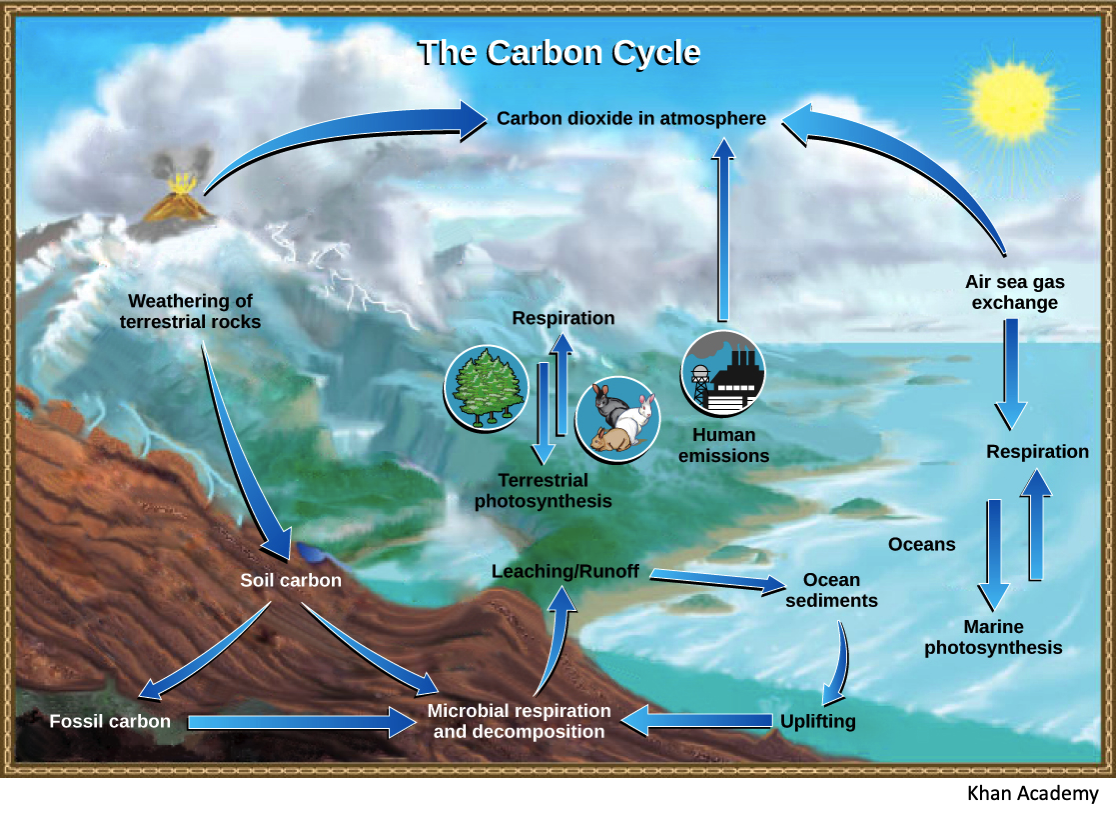
Chapter 2: Animal Ecology
Ecology: The relation of the animal to its organic as well as inorganic environment.
Introduced by Ernst Haeckel (German zoologist) in the mid-19th century

Environment and the Niche
An animal’s environment comprises all conditions that directly affect its chances for survival and reproduction.
Conditions/factors:
Abiotic
Space (habitat)
Forms of energy (sunlight, heat, wind, and water currents)
Materials (soil, air, water, chemicals)
Biotic
Other organisms
Prey, predators, competitors, hosts, mutualists, parasites
Niche
The role of an organism, population, or species in an ecological community
Components:
Resource usage
Unique way of life
Relationship to other abiotic and biotic factors
Subject to evolution by natural selection
Undergoes changes over successive generations
1. Fundamental Niche
Variety of potential roles an organism or population in an ecological community could perform
2. Realized Niche
The role actually performed by an organism or population in its ecological community at a particular time and place
Populations
Animals exist in nature as members of populations, or reproductively interactive groups of animals of a single species.
Deme: Geographically and genetically cohesive populations that are separated from other populations
Regularly interbreed + share a common gene pool
Each has its own characteristic demographics
Demography = the study of a population’s properties and factors that influence them
Sex ratio = accounting of the ages of individuals in a population at a particular time and place
Reveals whether the population is growing, stable, or declining
Growth rate
Age structure
Animal species have different characteristic patterns of survivorship
The proportion of a population that persists from one point in their life history, such as birth, to another one, such as reproductive maturity or death
3 principal types:
I: most die at old age
II: mortality rate is constant over all ages
III: infant or juvenile mortality is very high relative to that of young adults
Most animals do not survive to reach reproductive age
Those that do exhibit:
Semelparity: Condition in which an organism reproduces only once during its life history
Iteroparity: Occurrence of more than one reproductive cycle in an organism’s life
Population growth = birth rate – death rate
All populations have an inherent ability to grow exponentially if resources are unlimited
Exponential growth is not prevalent in nature
Limiting Factor: Resource in shortest supply relative to population needs
Carrying Capacity: The largest population that the limiting resource can support in a habitat
Community Ecology
Populations of animals that form a community interact in various ways
Can be detrimental (-), beneficial (+), or neutral (0)
Competition ( - / - )
Two or more species compete for a limited resource
Abundance of both species decreases
Predation ( + / - )
Predator abundance increases, prey abundance decreases
Parasitism ( + / - )
One species obtains nutrients from another species (host)
Usually does not kill the host
Parasite abundance increases, host abundance decreases
Commensalism ( + / 0 )
One species benefits, while the other is unaffected
Often occurs when one species provides a home or transportation for another
Benefitting species abundance increases, other species unaffected
Mutualism ( + / + )
Two species interact in a way that benefits both
Abundance of both increases
Competition and Resource Partitioning
Competition: Members of the same species attempt to use resources that are in limited supply, but are necessary for survival.
Result: not everyone has sufficient access to necessary resource(s)
How to reduce: resource partitioning
Different resource required for different groups
Parents don’t compete with offspring
Similar species don’t compete with each other
E.g. different food for different age groups
Selection of different microhabitats
Permits coexistence in the same tree
Feeding guild
Formed when several species share the same resources
Community Stability
Keystone Species: One on which the existence of a large number of other species in the community, and/or ecosystem, depends.
Stabilize the community, help maintain its characteristics, and helps to hold its web of interactions together
Examples:
Bats in tropical forests
Pollinators and seed dispersers
Without them, plants fail to reproduce
Sea otters in kelp forests
Eat sea urchins
Keeps population in check
Keeps urchins from eating too much kelp
Ecosystems
Species and the environment.
Ecological niche: The role the species plays in the community, its habitat, and its interactions with other species.
One important aspect: Acquiring food
Autotrophs
Produce their own food for themselves, and all other members of a community
Take in CO2
Release O2
Producers
Photoautotrophs
Chemoautotrophs
Heterotrophs: Consumers
Need a source of organic nutrients
Release CO2 into the atmosphere
Types: Herbivores, Carnivores, Omnivores, and Decomposers (bacteria + fungi)
Detritus = dead organism + bacteria and fungi that are breaking down the wastes
Energy Flow in Ecosystems
The living components of ecosystems process energy and chemicals.
Energy Flow: Begins when producers absorb energy
Passing organic nutrients from one organism to another results in a loss of energy
When an herbivore eats a plant, a portion of the nutrients is used as an energy source
Eventually, energy dissipates into the environment as heat
Visual representation: food web
2 types:
Grazing
Begins with plants
Detrital
Begins with bacteria and fungi
Organisms are linked to one another based on feeding relationships
Trophic Level
Level of nourishment within a food web
1st level: producers
2nd level: herbivores
3rd level: carnivores
Energy is lost between levels
Only ~10% of energy from one level is available to the next level
This is why so few carnivores can be supported in a food web

Chemical Cycling in Ecosystems
Chemical Cycling: Begins when producers take inorganic nutrients from the environment.
Biogeochemical Cycle
Pathways involve both living and nonliving components
Carbon Cycle
Returns to and is withdrawn from the atmosphere as a gas
Organisms exchange CO2 with the atmosphere
Terrestrial
Plants take up CO2
Incorporated into nutrients
Some returned to the atmosphere through respiration
Aquatic
Indirect CO2 exchange with the atmosphere
CO2 combines with water (bicarbonate ion)
Source of carbon for algae

Biodiversity
Described in terms of the number of different species
Currently: crisis
The number of extinctions expected to occur in the near future will, for the first time, be entirely attributable to human activities
Contributing Factors:
Habitat loss (85%) (Usually associated with sprawl of urban areas)
Introduction of exotic species (50%)
Water and air pollution
Overexploitation of natural resources (17%)
** in many cases, endangered species are threatened by multiple factors
People must understand that biodiversity is a resource of immense value.
Directly AND indirectly
Direct Values:
Medicinal value
Most prescription drugs in the US were originally derived from organisms
Examples:
Rosy Periwinkle (Madagascar)
Chemicals used to treat 2 types of cancer
The survival rate of childhood leukemia has gone from 10% to 90%
Hodgkin disease is now, usually, curable
Additional 328 types of drugs still in tropical forests, not yet found
Penicillin - derived from fungus
Immune cells in horseshoe crab blood
Detect bacterial contamination in vaccines and medical equipment
Indirect Values of Biodiversity
More economical to save ecosystems than individual species.
Types:
Biogeochemical cycles
Biodiversity within ecosystems keeps them balanced
Waste Disposal
Decomposers break down organic wastes
Prevention of soil erosion
Intact terrestrial ecosystems naturally retain soil
Climate Regulation
At the local level: trees provide shade, block drying winds, and reduce the need for fans & AC
Globally: forests regulate climate because they take up CO2
Ecotourism
Chapter 2: Animal Ecology
Ecology: The relation of the animal to its organic as well as inorganic environment.
Introduced by Ernst Haeckel (German zoologist) in the mid-19th century

Environment and the Niche
An animal’s environment comprises all conditions that directly affect its chances for survival and reproduction.
Conditions/factors:
Abiotic
Space (habitat)
Forms of energy (sunlight, heat, wind, and water currents)
Materials (soil, air, water, chemicals)
Biotic
Other organisms
Prey, predators, competitors, hosts, mutualists, parasites
Niche
The role of an organism, population, or species in an ecological community
Components:
Resource usage
Unique way of life
Relationship to other abiotic and biotic factors
Subject to evolution by natural selection
Undergoes changes over successive generations
1. Fundamental Niche
Variety of potential roles an organism or population in an ecological community could perform
2. Realized Niche
The role actually performed by an organism or population in its ecological community at a particular time and place
Populations
Animals exist in nature as members of populations, or reproductively interactive groups of animals of a single species.
Deme: Geographically and genetically cohesive populations that are separated from other populations
Regularly interbreed + share a common gene pool
Each has its own characteristic demographics
Demography = the study of a population’s properties and factors that influence them
Sex ratio = accounting of the ages of individuals in a population at a particular time and place
Reveals whether the population is growing, stable, or declining
Growth rate
Age structure
Animal species have different characteristic patterns of survivorship
The proportion of a population that persists from one point in their life history, such as birth, to another one, such as reproductive maturity or death
3 principal types:
I: most die at old age
II: mortality rate is constant over all ages
III: infant or juvenile mortality is very high relative to that of young adults
Most animals do not survive to reach reproductive age
Those that do exhibit:
Semelparity: Condition in which an organism reproduces only once during its life history
Iteroparity: Occurrence of more than one reproductive cycle in an organism’s life
Population growth = birth rate – death rate
All populations have an inherent ability to grow exponentially if resources are unlimited
Exponential growth is not prevalent in nature
Limiting Factor: Resource in shortest supply relative to population needs
Carrying Capacity: The largest population that the limiting resource can support in a habitat
Community Ecology
Populations of animals that form a community interact in various ways
Can be detrimental (-), beneficial (+), or neutral (0)
Competition ( - / - )
Two or more species compete for a limited resource
Abundance of both species decreases
Predation ( + / - )
Predator abundance increases, prey abundance decreases
Parasitism ( + / - )
One species obtains nutrients from another species (host)
Usually does not kill the host
Parasite abundance increases, host abundance decreases
Commensalism ( + / 0 )
One species benefits, while the other is unaffected
Often occurs when one species provides a home or transportation for another
Benefitting species abundance increases, other species unaffected
Mutualism ( + / + )
Two species interact in a way that benefits both
Abundance of both increases
Competition and Resource Partitioning
Competition: Members of the same species attempt to use resources that are in limited supply, but are necessary for survival.
Result: not everyone has sufficient access to necessary resource(s)
How to reduce: resource partitioning
Different resource required for different groups
Parents don’t compete with offspring
Similar species don’t compete with each other
E.g. different food for different age groups
Selection of different microhabitats
Permits coexistence in the same tree
Feeding guild
Formed when several species share the same resources
Community Stability
Keystone Species: One on which the existence of a large number of other species in the community, and/or ecosystem, depends.
Stabilize the community, help maintain its characteristics, and helps to hold its web of interactions together
Examples:
Bats in tropical forests
Pollinators and seed dispersers
Without them, plants fail to reproduce
Sea otters in kelp forests
Eat sea urchins
Keeps population in check
Keeps urchins from eating too much kelp
Ecosystems
Species and the environment.
Ecological niche: The role the species plays in the community, its habitat, and its interactions with other species.
One important aspect: Acquiring food
Autotrophs
Produce their own food for themselves, and all other members of a community
Take in CO2
Release O2
Producers
Photoautotrophs
Chemoautotrophs
Heterotrophs: Consumers
Need a source of organic nutrients
Release CO2 into the atmosphere
Types: Herbivores, Carnivores, Omnivores, and Decomposers (bacteria + fungi)
Detritus = dead organism + bacteria and fungi that are breaking down the wastes
Energy Flow in Ecosystems
The living components of ecosystems process energy and chemicals.
Energy Flow: Begins when producers absorb energy
Passing organic nutrients from one organism to another results in a loss of energy
When an herbivore eats a plant, a portion of the nutrients is used as an energy source
Eventually, energy dissipates into the environment as heat
Visual representation: food web
2 types:
Grazing
Begins with plants
Detrital
Begins with bacteria and fungi
Organisms are linked to one another based on feeding relationships
Trophic Level
Level of nourishment within a food web
1st level: producers
2nd level: herbivores
3rd level: carnivores
Energy is lost between levels
Only ~10% of energy from one level is available to the next level
This is why so few carnivores can be supported in a food web

Chemical Cycling in Ecosystems
Chemical Cycling: Begins when producers take inorganic nutrients from the environment.
Biogeochemical Cycle
Pathways involve both living and nonliving components
Carbon Cycle
Returns to and is withdrawn from the atmosphere as a gas
Organisms exchange CO2 with the atmosphere
Terrestrial
Plants take up CO2
Incorporated into nutrients
Some returned to the atmosphere through respiration
Aquatic
Indirect CO2 exchange with the atmosphere
CO2 combines with water (bicarbonate ion)
Source of carbon for algae

Biodiversity
Described in terms of the number of different species
Currently: crisis
The number of extinctions expected to occur in the near future will, for the first time, be entirely attributable to human activities
Contributing Factors:
Habitat loss (85%) (Usually associated with sprawl of urban areas)
Introduction of exotic species (50%)
Water and air pollution
Overexploitation of natural resources (17%)
** in many cases, endangered species are threatened by multiple factors
People must understand that biodiversity is a resource of immense value.
Directly AND indirectly
Direct Values:
Medicinal value
Most prescription drugs in the US were originally derived from organisms
Examples:
Rosy Periwinkle (Madagascar)
Chemicals used to treat 2 types of cancer
The survival rate of childhood leukemia has gone from 10% to 90%
Hodgkin disease is now, usually, curable
Additional 328 types of drugs still in tropical forests, not yet found
Penicillin - derived from fungus
Immune cells in horseshoe crab blood
Detect bacterial contamination in vaccines and medical equipment
Indirect Values of Biodiversity
More economical to save ecosystems than individual species.
Types:
Biogeochemical cycles
Biodiversity within ecosystems keeps them balanced
Waste Disposal
Decomposers break down organic wastes
Prevention of soil erosion
Intact terrestrial ecosystems naturally retain soil
Climate Regulation
At the local level: trees provide shade, block drying winds, and reduce the need for fans & AC
Globally: forests regulate climate because they take up CO2
Ecotourism
 Knowt
Knowt
